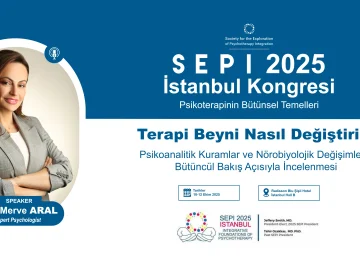Clinical Psychologist Merve Aral will be a speaker and panel moderator at the SEPI Istanbul Congress between October 10–12, 2025, presenting on “Neuroplasticity and the Neurobiological Foundations of Psychotherapy.”
The presentation will address the scientific foundations of psychotherapy, highlighting that it is not merely a process that reduces psychological symptoms, but rather a profound transformation process that creates lasting changes in the structure and functioning of the brain through neuroplasticity. Advancing neuroimaging techniques are increasingly revealing the effects of the therapeutic relationship on synaptic reorganization, emotional regulation, and the integration of social brain networks.
Below is a summary of the scientific content of the presentation:
Summary
Advancing neuroimaging techniques reveal that psychotherapy is not merely a process that reduces symptoms in the brain; it also creates lasting structural and functional changes through neuroplasticity. Psychotherapy exerts its effects through synaptic reorganization, emotional regulation, and the integration of social brain networks.
Eric Kandel’s (1998) assertion that learning creates lasting changes at the synaptic level has laid the foundation for conceptualizing psychotherapy as a learning process at the neural level. Allan Schore (2003, 2012) emphasized the critical role of the right brain in emotional regulation, attachment, and nonverbal communication, proposing that the therapeutic relationship is reestablished through right-brain-based resonance. Louis Cozolino (2010, 2017), on the other hand, evaluates psychotherapy within the framework of social brain integration, drawing attention to the central role of the orbitofrontal cortex and limbic system in the therapeutic process.
Research shows that, independent of technical interventions, the therapeutic alliance, the therapist’s empathetic stance, and regulatory role are decisive in treatment success (Wampold, 2015). Psychotherapy reorganizes the client’s emotional regulation, strengthens synaptic connections, and contributes to the establishment of new neural networks.
Consequently, psychotherapy should be approached from an interdisciplinary perspective: neurobiology, psychology, and clinical practice are complementary elements. Future advances in neuroimaging techniques will contribute to the development of more evidence-based interventions, both scientifically and clinically, by revealing the neurobiological correlates of therapeutic processes in the brain more clearly.
NEUROPLASTICITY AND THE NEUROBIOLOGICAL BASES OF PSYCHOTHERAPY
Thanks to advancing neuroimaging techniques, structural and functional changes occurring in the brain during psychotherapy can now be directly observed. Psychotherapy does not merely reduce symptoms; it creates lasting synaptic changes through the brain’s neuroplasticity capacity. This process progresses particularly in relation to the quality of the therapeutic relationship and right-brain-based emotional interactions.
Eric Kandel and Neuroplasticity
Eric Kandel has proposed that learning changes synaptic structures at the neural level and that this change forms the biological basis for long-term therapeutic effects. The ability of insights gained in therapy to create lasting changes in the brain is related to synaptic changes that require protein synthesis (Kandel, 1998). Therefore, psychotherapy should be considered a learning process at the neural level.
Allan Schore and the Right Brain Perspective
According to Schore’s work, the right brain plays an important role in emotional regulation, attachment, and nonverbal communication. The right-brain-to-right-brain resonance established with the mother during infancy can be reestablished between the therapist and the client during the therapy process. The therapist facilitates emotional regulation by mirroring the client’s right brain activations.
Louis Cozolino and the Social Brain
Louis Cozolino defines psychotherapy through the integration of social brain networks. The orbitofrontal cortex (OFC) and limbic system are particularly active in the therapeutic process. Within the secure relationship established with the therapist, the client can reorganize both their self-perception and their relational patterns with others (Cozolino, 2010).
Common Factors and the Therapist’s Regulatory Role
The psychotherapy process is not limited to technical interventions. The therapist’s personality, approach, and the relationship they establish are central to the therapeutic process. The therapist is not merely an information provider but a “regulatory other” who calms and reorganizes the client’s nervous system.
All effective psychotherapy approaches share certain common healing elements:
- Strong therapeutic alliance
- The therapist’s empathetic stance
- Creating hope and expectation for change
- Interpretation and reframing skills
- Joint provision of emotional regulation
The Neurobiology of the Relationship in the Therapy Room
The therapist’s right-brain-based empathetic stance directly affects the client’s limbic system. Schore (2012) states that this synchronization is critical in establishing a therapeutic bond. The therapist’s facial expressions, tone of voice, and body posture create a regulatory effect in the client through right-brain-to-right-brain communication. Freud’s concepts of transference and countertransference are the theoretical foundations of this process. While allowing the client to reenact past relationship patterns, the therapist contributes to the establishment of new connections by providing healthy responses to these patterns (Kandel, 2006).


